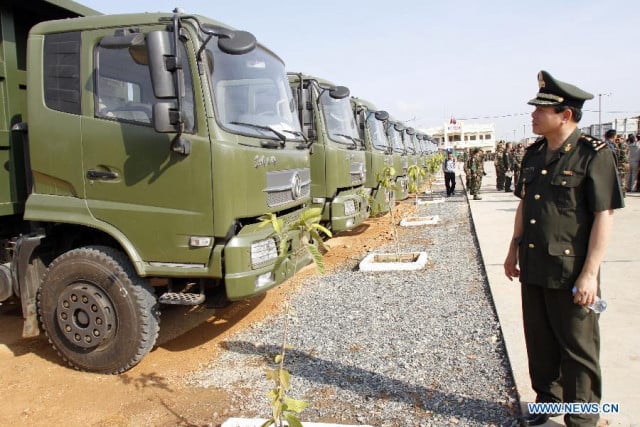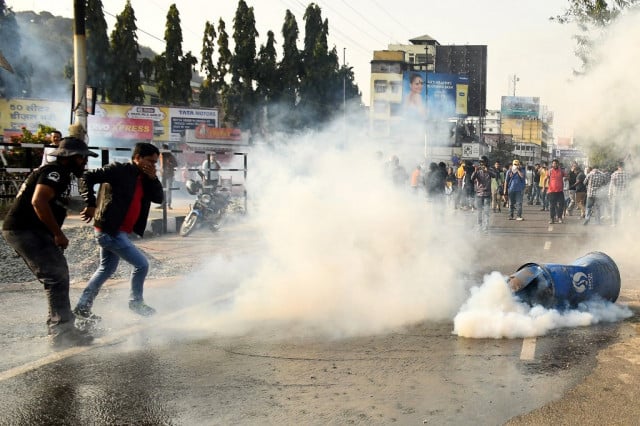IRD Studies the Impact of the Monsoon on Public Health in Cambodia

- By Lepetitjournal Cambodge
- June 29, 2023 10:52 AM
PHNOM PENH – In Cambodia, the year is punctuated by the arrival of the monsoon. Whether it comes early or late, how sudden it is, and how much water there is, are all essential factors in determining agricultural production.
While it is well known that the monsoon plays an essential role in the country's food security, the Institute of Research for Development in Cambodia (IRD) has tried to take a new approach to the matter.
The multidisciplinary French public research organization asked itself whether this alternation of periods of flooding and drought could have major health consequences in terms of water-borne pathogens and the transport of pollutants.
For the past fifteen years, the IRD has been developing research activities in the country in major fields: Environmental sciences and agronomy, public health, and human and social sciences.
Sylvain Massuel, a quantitative hydrogeologist working at the research institute, has made the evolution of water resources his subject of study.
The flooded areas of the upper Mekong Delta – which span over the southern parts of Kandal, Takeo, Kampot, Prey Veng and Svay Rieng provinces – have become his favorite field of research. Using modeling and field surveys, coupled with microbiological analyses and procedures to identify vulnerabilities of all kinds, the researcher coordinates a truly interdisciplinary study on water, alongside other IRD scientists and Cambodian institutional partners such as the Institute of Technology of Cambodia (ITC), the Pasteur Institute of Cambodia (IPC) and the Royal University of Agriculture (URA).
 Sylvain Massuel, a quantitative hydrogeologist working at the research institute, has made the evolution of water resources his subject of study. Photo provided
Sylvain Massuel, a quantitative hydrogeologist working at the research institute, has made the evolution of water resources his subject of study. Photo provided
This is how the Wat Health Project came to life in 2021, with financial support from France through the Solidarity Fund for Innovative Projects (Fonds de Solidarité pour les Projets Innovants). It aims to define the vulnerability of rural populations to the health risks associated with seasonal flooding and tries to anticipate the most appropriate responses.
Le PetitJournal.com (LPJ) went to meet him to better understand his research.
LPJ: Water is an essential element in the lives of Cambodians. People obviously think of flooding and fishing, but aren't there other essential issues that deserve to be studied?
Sylvain Massuel: There are, of course, other water-related issues. Contrary to popular belief, while water is plentiful during the monsoon season, it can be scarce at the end of the dry season. In many provinces, growing crops during this period represents a major risk of crop failure. Without available water, it is not possible to grow crops before the first monsoon rains. This represents a real challenge for regional economic development.
In the upper Mekong Delta, the annual flooding of the river floods the plains and brings fertile sediments. From the early 19th century onwards, hundreds of small canals were built to divert the river's waters and facilitate the accumulation of silt. As soon as the floodwaters receded, the waterlogged land could be worked and then cultivated, limiting the need for irrigation water.
Therefore, there is a double challenge in water management. First, it is essential to drain the water quickly so that the arable land can emerge and benefit from the last rains of the season. Second, farmers must conserve the water in the canals so that it can be used for irrigation in the dry season. As a result, up to three rice harvests can be made in a year, and vegetables can be grown outside the monsoon season.
These infrastructures and farming practices help to control the inflow and outflow of water to and from the plain. They modify how flooding occurs and therefore change humidity conditions in time and space. This raises several questions about the consequences of these changes: If the areas that are usually dry or under water change, or if the duration of flooding changes, what effects could this have on ecosystems and water quality? Which species will benefit or lose from it? Are we facing the disappearance or proliferation of certain pathogens or disease-carrying animals such as rodents or mosquitoes? What are the associated health risks for local populations? These are the questions we wanted to ask and study in an agricultural region south of Phnom Penh.
LPJ: What human and financial resources have you assembled for the Wat Health Project?
Sylvain Massuel: It is easy to see that to answer these kinds of questions, you need to bring together experts in a number of scientific fields, including hydrology, epidemiology, microbiology, entomology, chemistry, geography and the human and social sciences. The project therefore involved around 40 people from the various partners. A major challenge was to get all these people to work together towards a common goal. Substantial resources – financed by the Ministry of Europe and Foreign Affairs via the French Embassy in Cambodia as part of the Solidarity Fund for Innovative Projects – were deployed over two years to fund this research, but also to provide the partners with the necessary equipment and enhance the expertise of Cambodian agents in certain analysis techniques.
LPJ: One can easily imagine that scientific work in the field is no easy task. Have you encountered any particular difficulties since the research began?
Sylvain Massuel: Collecting socio-environmental data to carry out a detailed inventory requires a lot of work in the field. For example, many interviews with local residents and farmers were necessary to understand irrigation practices and the use of pesticides. Thousands of water and soil samples had to be taken, with experimental conditions that were sometimes very restrictive. The teams had to improvise, depending on the season, to access the same sampling points each month, which were sometimes made very difficult to reach by the rain. An important part of the study was to determine the current or past presence of infection among the inhabitants, to measure the population's exposure to certain bacteria. This involved taking blood samples and therefore obtaining ethical agreements in coordination with the authorities and the local population. The COVID-19 pandemic also made it difficult to carry out such activities in the best possible conditions. Some of our Cambodian colleagues had planned to train in a laboratory abroad. One young father-to-be almost didn't make it home in time for his wife's delivery. These kinds of stories also reinforce teamwork!
LPJ: Have you been able to gather satisfactory results so far? And what can you tell us about them?
Sylvain Massuel: The data is still being analyzed, but some results have already emerged. We note, for example, that the Culex vishnui mosquito species is the most widespread in the dry season. These mosquitoes are known to like rather warm, stagnant water and to be the most important vectors of the Japanese encephalitis virus. This means that they do not proliferate during major seasonal floods but they do thrive in the puddles maintained by irrigation.
However, we have also shown that from 2008 onwards, the average duration of floods has been reduced by almost three weeks, further extending the period favorable to their development.
We also inventoried more than 300 different pesticide products used in the area. Some of these are found in groundwater, posing a potential risk to the quality of drinking water. Water-borne pathogenic bacteria responsible for diseases such as leptospirosis and melioidosis have been detected in the environment. Some bacteria are present in wet soils, others directly in water or flooded soils, and our study determining the presence of infection in residents revealed high human exposure to these two bacterial diseases in this agricultural area. A great deal of data still needs to be cross-referenced to really capitalize on all this multidisciplinary work.
LPJ: What exactly will this research and the summary of your results be used for?
Sylvain Massuel: It's always difficult to assess the real contribution of a research project, because results can prove decisive several years after they are discovered, and sometimes in unexpected contexts. Nevertheless, identifying the presence in the environment of bacteria responsible for infectious diseases will enable us to better inform, monitor and diagnose these bacterial diseases, which are still little known in Cambodia. There are real challenges ahead in terms of adapting care protocols. We also now have a better understanding of the path followed by certain pesticides and possible areas of accumulation. This makes it possible to anticipate changes in the situation and highlights the need to better inform and support farmers in their practices.
While the Wat-Health Project ended in 2022, it is worth mentioning that it was not only a research project. It also encouraged interaction between different institutions in Cambodia and trained scientists in new analysis tools. A data dashboard is now available online and will enable public access to the results for longer-term monitoring.
Originally written in France for LePetitJournal.com, this story was translated for Cambodianess.















